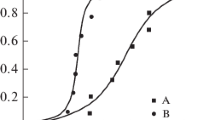Conclusions
-
1.
Use of the finite-element method made it possible to evaluate features of the stress-strain state of composite specimens and to establish the principle structural parameters and technological factors affecting stress-strain state and supporting capacity.
-
2.
A theoretical basis was found for a test method for brittle materials under uniaxial compression in holders, and the effect of each selected parameter on the stress-strain state of a brittle rod was studied over a wide range.
-
3.
The possibility of solving the choice of optimum composite specimen shape by a numerical method was considered.
From the stress state analysis, recommendations were made for the geometric shape of a composite specimen with data for the ratios of brittle material and metal holder elastic constants, and also glued joints,
-
4.
Fulfillment of these recommendations makes it possible to increase supporting capacity and to decrease scatter of values for brittle material composite specimens.
-
5.
The prospects for using the finite-element method of evaluating composite structures of brittle materials was noted.
Similar content being viewed by others
Author information
Authors and Affiliations
Additional information
Translated from Problemy Prochnosti, No. 4, pp. 86–90, April, 1979.
Rights and permissions
About this article
Cite this article
Kvitka, A.L., D'yachkov, I.I. Selection of optimum specimen shape for compression tests on brittle materials. II. Strength Mater 11, 438–443 (1979). https://doi.org/10.1007/BF00767698
Received:
Issue Date:
DOI: https://doi.org/10.1007/BF00767698




